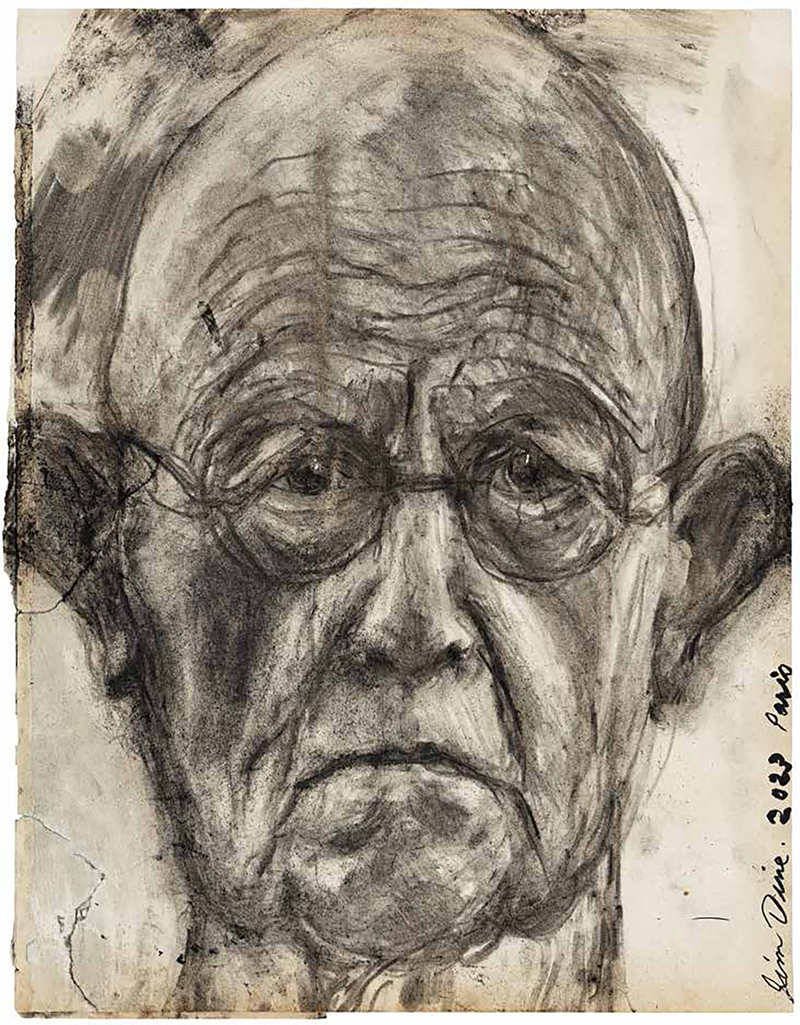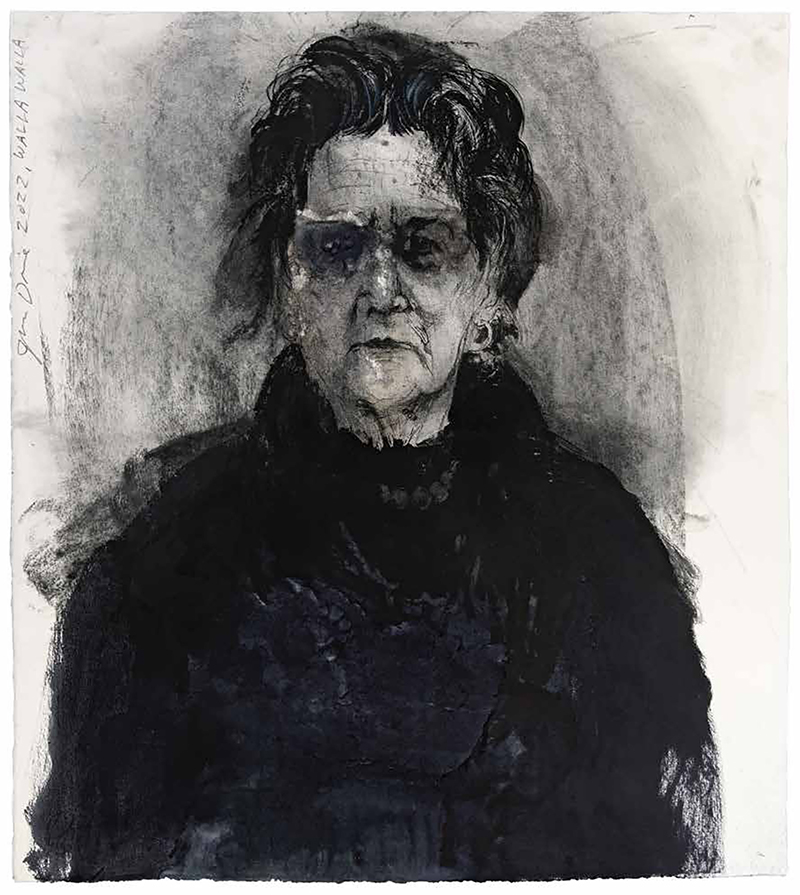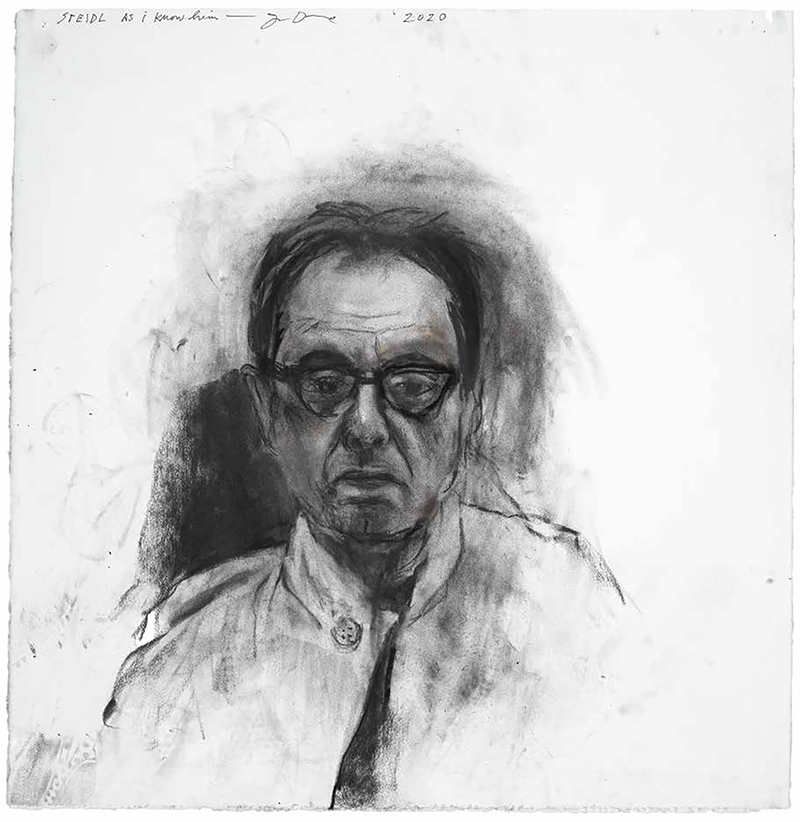Jim Dine: "Last Year’s Forgotten Harvest" opens in December
By Bowdoin College Museum of Art
Self-Portrait, 2023, charcoal on paper, 11 1/4 x 11 1/8 in. (28.5 x 22 cm). Bowdoin College Museum of Art, Gift of the Jim Dine Art Trust.
On December 7th, the Bowdoin College Museum of Art looks forward to opening Jim Dine: Last Year’s Forgotten Harvest, featuring over 60 of the artist’s exceptional portrait drawings, created over the past six and a half decades, from 1957 until 2023. It will be on view until June 2nd. The result of several generous gifts by the artist in recent years, the exhibition provides a remarkable overview both of the artist’s strong commitment to the practice of drawing and to individuals who have shaped his life personally and professionally. As Dine has remarked: “Besides being a diary, having the quality of a diary, the exhibition is essentially about drawing.”1 In another context, he elaborates: “For me, drawing is all about looking—looking hard, seeing it, taking it out, putting it back again to see if I rebuild it better.”2
Opening the exhibition is a self-portrait by the artist, completed recently. Reflecting on his long career, Dine observes: “I’m interested in the passage of time. I don’t mean metaphysically; I mean physically. I’m interested in what the flesh does…. It changes, and it’s therefore, plastically, very interesting to depict it. And what better way to depict it than to do it of yourself, by yourself? It’s about observing, and it’s about what your eyes can do and how you can get your eyes to concentrate with your hand and your mind.” Dine’s sensitivity to temporality not only plays out through his faithful depictions of his own visage, but also through his process. As the drawings in Last Year’s Forgotten Harvest reveal, each work is a construction, the accumulation of marks made over hours, days, weeks, and even years as Dine sat with his subjects, or meditated upon their features in private. Using what he terms a method of “correction,” Dine continually returns to his work, erasing and replacing line, allowing himself to reveal his process of making and remaking. “The pentimento has an emotional quality to it,” notes Dine. “It's hands across the unconscious, from what the unconscious spills out to where it came from.”
The works that result from Dine’s careful scrutiny and his relentless commitment to revisiting his compositions assert their materiality boldly. The scarred surfaces of Dine’s drawings become analogous to the flesh they represent, reflecting both the breakdown but also the development of personal character that mark the face of human beings as they age. Thus, the blemishes, wrinkles, and even stains that appear upon the surfaces of Dine's drawings as he works and reworks them mirror those that time imprints on the faces of his subjects.
 While Jim Dine is well known for his depictions of self, which early in career were often purely symbolic—most famously in the form of a bathrobe or a set of tools—this exhibition, in its entirety, creates another portrait of sorts of the artist, providing the viewer with exposure to his techniques as a maker and to the individuals in his orbit who have helped to shape him. As Dine remarks about the show: “The ‘forgotten harvest’ drawings have been done over the last 65 years. I never thought of them as a group but in total they are a large, varied memory of the lifelong conversation I have had with drawing and, not absurdly, with each sitter. My subject has always been primarily the act of drawing itself but with this group I have memorialized a wide swarth of my now 88 years. The main thing is that to be on this highway this long, they are a record of a million marks, a history of their erasure, and the pleasure of doing it again.”3
While Jim Dine is well known for his depictions of self, which early in career were often purely symbolic—most famously in the form of a bathrobe or a set of tools—this exhibition, in its entirety, creates another portrait of sorts of the artist, providing the viewer with exposure to his techniques as a maker and to the individuals in his orbit who have helped to shape him. As Dine remarks about the show: “The ‘forgotten harvest’ drawings have been done over the last 65 years. I never thought of them as a group but in total they are a large, varied memory of the lifelong conversation I have had with drawing and, not absurdly, with each sitter. My subject has always been primarily the act of drawing itself but with this group I have memorialized a wide swarth of my now 88 years. The main thing is that to be on this highway this long, they are a record of a million marks, a history of their erasure, and the pleasure of doing it again.”3
 Present in the exhibition are members of Dine’s family—his sons Jeremy, Matt, and Nick, and their mother, his first wife Nancy. Dine's wife Diana appears in multiple, heavily worked portraits including Walla, Walla (2022), reproduced here. Close friends and fellow creatives also play an important role, including the artist Susan Rothenberg, the printer Aldo Crommelynck, the poet Robert Creeley, and the publisher Gerhard Steidl. Viewers will also encounter portraits of historic figures with whom Dine closely identifies, including the nineteenth-century poet Arthur Rimbaud and the twentieth-century expressionist artist Max Beckmann.
Present in the exhibition are members of Dine’s family—his sons Jeremy, Matt, and Nick, and their mother, his first wife Nancy. Dine's wife Diana appears in multiple, heavily worked portraits including Walla, Walla (2022), reproduced here. Close friends and fellow creatives also play an important role, including the artist Susan Rothenberg, the printer Aldo Crommelynck, the poet Robert Creeley, and the publisher Gerhard Steidl. Viewers will also encounter portraits of historic figures with whom Dine closely identifies, including the nineteenth-century poet Arthur Rimbaud and the twentieth-century expressionist artist Max Beckmann.
Jim Dine: Last Year’s Forgotten Harvest is accompanied by an eponymous fully illustrated catalogue, designed by the artist in tandem with Steidl, one of his portrait subjects. With a statement by Dine and an essay by Anne Collins Goodyear, the volume provides beautiful illustrations of each portrait in the show and includes biographical notes about the sitters and the artist. The book also features an insert featuring a transcription of a conversation between Dine and Goodyear conducted in October 2021. The discussion provides an opportunity for the artist to discuss the works included in the exhibition as well as to reflect more broadly on his career and his creative practice.
Programming for the exhibition will include a public presentation by Jim Dine on Friday, February 23, 2024.
Notes:
1 Unless otherwise indicated, all quotations are from Jim Dine in Conversation with Anne Collins Goodyear (Göttingen: Steidl, and Bowdoin College Museum of Art, Brunswick, Maine, 2023).
2 Jim Dine, “Putting Down Marks (my life as a draftsman),” in Drawings of Jim Dine, by Judith Brodie (Washington, DC: National Gallery of Art, and Steidl, Göttingen, 2004), 27.
3 Jim Dine, in Jim Dine: Last Year’s Forgotten Harvest (Göttingen: Steidl, and Bowdoin College Museum of Art, Brunswick, Maine, 2023), 7.
Anne Collins Goodyear, Co-Director
Bowdoin College Museum of Art
Illustrations
Walla Walla, 2022, charcoal on paper, 22 1/2x 20 1/2in. (57.15 x 52.07 cm). Bowdoin College Museum of Art, Gift of the Jim Dine Art Trust.
Portrait of Gerhard Steidl, 2020, charcoal on paper, 31 1/8 x 30 1/8 in (79 x 76.5 cm). Bowdoin College Museum of Art, Gift of the Jim Dine Art Trust.